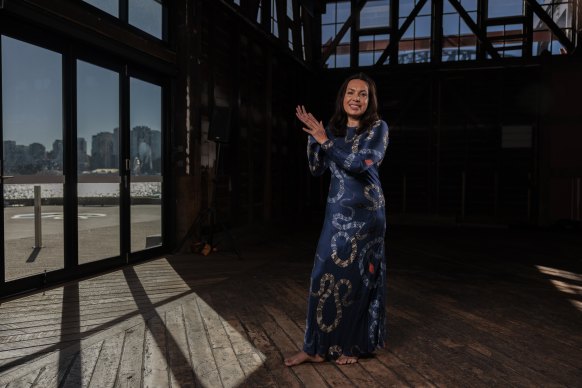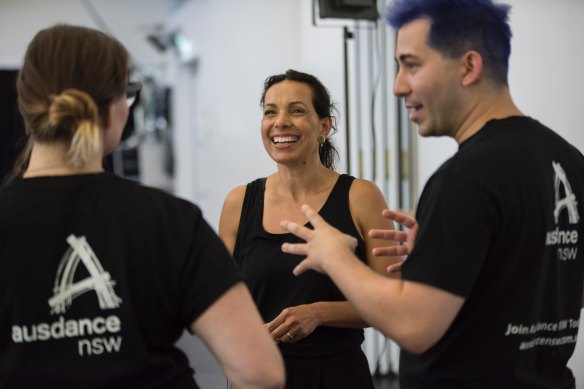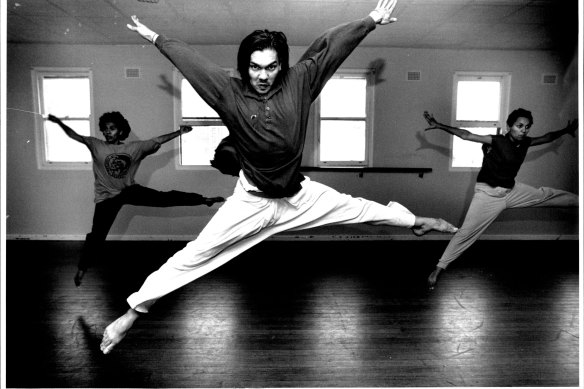This was published 1 year ago
‘Build up that layer of hard goanna skin’: Behind the scenes of a big debut
By Linda Morris

Bangarra dancers Daniel Mateo and Kassidy Waters with artistic director Frances Rings.Credit: Brook Mitchell
Frances Rings retains the posture and poise of a dancer even though it’s been seven years since she last took to the stage. Those days are well behind her, but she can still manage the splits and hip swivels though the knees creakily protest the mornings.
Maintaining peak personal fitness in her 50s via a somewhat gruelling training technique known as hot yoga is a “mountain to climb”, but it’s part of a broader personal mantra for the new artistic director of Bangarra Dance Theatre.
“I’m trying to teach it to my children as well about the reality of life. Life is not straightforward and each day is different,” Rings says.
“Each day will give you a mountain that you have to climb, and it will challenge you. A mountain is one foot in front of the other, and that’s all you need to do.

Bangarra’s new artistic director Frances Rings.Credit: Brook Mitchell
“You can stop and pause, but then you need to keep walking forward. It’s the grit that you need to build up. Stephen Page used to call it goanna skin: ‘Build up that layer of hard goanna skin,’ he’d say.”
We are in the Bangarra studio overlooking Walsh Bay, a space Page, the former artistic director, called the sacred cave. A rehearsal of Yuldea, Rings’ first full-length production at Bangarra’s helm, is underway. It’s a test of those mountaineering qualities she espouses.
Page, a charismatic visionary who took Bangarra from a dance version of Fame to the world stage, was Bangarra’s centre of gravity for 33 years. Now it’s time for Rings, Page’s protege and a notable choreographer in her own right, to make her debut in the role.
Yuldea is the story of her mother’s people who come from the semi-arid desert region of South Australia, on the edge of the Great Victorian Desert.
“You don’t want to get it wrong, that’s for sure,” Rings says. “There have been a few sleepless nights in making sure we’ve got that balance in elevating forms of story and making sure that the distinctive voice of the Anangu people exists in there, and that it is not a one-size-fits-all. You have to give each story the justice they deserve.”

Bangarra’s former artistic director, Stephen Page, with Rings. Credit: Paul Jeffers
When we meet, Rings sits in a hoodie at a table, flanked by rehearsal director Daniel Roberts and set designer Elizabeth Gadsby, mulling over the knotty transitions between scenes.
Yuldea’s troupe of 17 dancers brings to life the first starburst that created the galaxy, the gaseous soup from which Earth was formed, the buckling of continents, the evolution of creatures, and the arrival and, later, colonial dispossession of the Anangu people. It’s visceral, physical storytelling.
As the last notes of Yuldea’s soundtrack die away with dancer Rikki Mason writhing in a radiation cloud, there are whoops and applause from the performers and onlookers.
Rings is pleased, but aiming for perfection. She shares her notes while sitting on the floor with the dancers, legs outstretched, toes flexed, and back straight as a ballerina. Rings advises the dancers to find more shape and energy in their legs and light and shade in their movement. Their stage walks need to be more purposeful. “Walk into the space,” she says. “You need to really arrive, it gives over a sense of shift, to show a change in gear.”
To a soloist, she recommends becoming a little more “gooey”: “You want to feel like you are boneless, and think like you are water.”
Bangarra was founded by dancer and choreographer Carole Y. Johnson in 1989 in the aftermath of Australia’s bicentenary celebrations, which framed nationhood around European settlement, and spurred an Indigenous-led movement for self-determination and cultural expression.

Frances Rings says she has had a few sleepless nights in the lead-up to her debut work as artistic director.Credit: Amanda James
At Bangarra, Page and his brothers, Russell and David, pioneered a unique vocabulary for storytelling that fused contemporary and traditional forms of Indigenous dance.
Rings was there almost from the beginning. She was auditioning for the National Aboriginal Islander Skills Development Association at Redfern when she was introduced to Page, who was then a star of Sydney Dance. Page became her mentor, and Bangarra’s Unaipon, SandSong and Terrain bear her DNA.
After leaving Bangarra to start a family, Rings returned in 2019 as associate artistic director. It was the year Page’s major work, Bennelong, won six Helpmann Awards, but he was still processing the loss of brother David, two years before, and was close to exhaustion.
How do you exit a performing arts company of which you have been the primary creative force? Decisively, it seems.
Page packed up his belongings in March – books, framed photos and other collectibles were sent to storage – and he passed on Rings’ offer of a hot desk.
“You know what, I said it was probably going to be better for me to uproot and walk. I’d always known that getting to the end of that third decade at Bangarra would be hard, and every now and then I would think, ‘Oh, I’ve got to let go’,” Page says.
“It took me a while, and Fran helped me cue for that decision, and then it was natural from there, and it was like, ‘Are you ready, sister? Because I’m getting out of here.’ ”
Bangarra’s audiences have bounced back to 2019 levels after COVID interruptions and executive director Ken Markwell is on watch for, but not expecting, any drift in loyalty with the handover.

Stephen Page in the early days of the Bangarra Dance Theatre.Credit: SMH
“Our audiences, donors, funders, and other stakeholders remain loyal to Bangarra because of our mission to share stories and create inspiring experiences that promote Indigenous culture,” Markwell says. “This is greater than any individual.”
Page and Rings are as close as siblings and like-minded in their ambitions for Bangarra. Rings, however, is much more structured and researched in her approach to storytelling than Page, whose style is to “go with my imagination” and enjoy the challenge of a blank canvas.
“It’s not about picking a picture out of a book and choreographing a work, and saying, ‘there it is’, and it’s got no life,” Page says of the artistic process. “Bangarra’s works have to be marketable in a conscious way so they can live in our repertoire and go on to regional and global touring. Fran is very aware of all those cultural ingredients and mechanics that make that work. It’s that foot in each world.”
Rings’ father was a German migrant worker who worked between camps on the Trans Australian Railway, a post-Federation project of east and west state unification. She was baptised by the local priest in the railway township of Kingoonya in the central outback of South Australia.
When her parents separated she followed her father to Kalgoorlie and Albany, in Western Australia, returning to meet her mother’s people when she was 20 years old. By then she was training to be a dancer.
“That was a turning point in my life,” she says. “I felt that I’d finally landed, that I was finally part of something. I looked into the eyes of my mother and our extended family and felt this sense of belonging and interconnectedness. It wasn’t awkward, it wasn’t, ‘Who are you? We haven’t seen you for your whole childhood’. It was this sense, ‘you are finally home’.”
Foundational stories from those missed childhood years underpin Yuldea’s storyline: her grandmother’s meeting with Daisy Bates, the Irish-born anthropologist who camped at Yuldea (Ooldea is the Western place name), the coming of the railway that scarred the land, the thirsty steam locos that drained the natural water soak dry, and Britain’s atomic testing on Maralinga during the 1950s which poisoned sacred lands.
“I want people to know who I am, the stories of my people, and I wanted to share that story as my first work with Bangarra,” she says.
Yuldea marks the collision point between traditional life and the industrial ambitions of a young nation, which didn’t end well for either: the Anangu people remain displaced from their original home, while the remnants of colonial progress have since been swallowed by the desert.
“Our history is an incredible mirror in front of a nation,” Rings says. “To be able to look deep into it and to know how this country was settled – the truth-telling of it means that we know it came at a cost and there were consequences.”
Rings’ Yuldea premieres in the campaign build-up to the Voice referendum, of which she and the board have taken a public stance supporting a Yes vote.
Rings cites her sons, aged 14 and 17, and the kind of future that she wants for them when declaring her position, and they aren’t far from her mind as she considers the kind of arts company she wants to lead.
It pains her greatly that her sons still experience casual racism and that Aboriginal disadvantage remains so stubbornly entrenched.
“Fran’s vision is very clear,” says Mason. “She is looking for that next generation of storytellers. You’ve got a full company of them but also other ones outside the company that are waiting in the wings, and not just as dancers, with music too. We have First Nations set designers she brought in for Dance Clan and the question always is, how can the next generation of Bangarra storytellers really grow?”
Yuldea will also introduce Bangarra audiences to original music by Leon Rodgers and songs by multi-award-winning electronic pop duo Electric Fields.
“I’m not about reinventing, but I’m committed to growing and elevating Aboriginal and Torres Strait Islander people, stories, and programs sustainably into the future,” she says.
Page will be overseas for opening night but the pair text each other frequently and Rings still asks herself, “What would Stephen do?”
“It’s good to stand on your own and find your feet but, yeah, he’s everywhere in this building, him and his brothers.”
Yuldea runs at the Sydney Opera House from June 14 to July 15.
To read more from Spectrum, visit our page here.
Find out the next TV, streaming series and movies to add to your must-sees. Get The Watchlist delivered every Thursday.